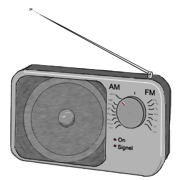The Basics on Personal AM/FM Radios
Created | Updated Jun 27, 2007

A personal AM/FM radio can be the perfect accessory to take along on a walk or jog1 or when you're exercising at home or in the gym. Many of these lightweight, portable radios are weatherproof, which means you never have to worry about ruining your radio by being caught in a storm or splashed by a car driving through a puddle.
Controls
Nearly all these radios use just one or two 'AA' or 'AAA' batteries, which will provide between 20 to 40 hours of extremely economic listening - more so if you choose the rechargeable option. The radios usually come with either a single mono earphone, or a set of stereo headphones as well as a belt clip, to provide 'hands off' listening. On the more sophisticated models, the radio tuner, volume control and AM/FM switch are located on the headphones, to provide better accessibility when jogging or exercising by not obliging you to access the base unit. In some cases, the base unit is dispensed with entirely - everything is built in to the headphones2.
Features
Features to look for in a personal AM/FM radio include a local/distant 'DX' switch, which provides optimal reception of both near and distant stations and digital synthesised tuning, which locks in the most powerful signal for accurate, drift-free reception. Station presets, which enable you to switch to your favourite stations with the push of a button, are also a must for quick, easy access to favourite programmes or channels.
Incidentally, if you like sport and are planning to take your radio to a football match to keep tabs on events elsewhere, check that your radio has AM as well as the more popular FM - most sports stations3 only broadcast on AM. For those of you that are fond of cricket, it's worth noting that Test Match Special is broadcast on long wave, which can't be picked up on most personal radios. Probably the best solution here would be to invest (heavily) in a digital radio4.
The Best Possible Fit
Many personal AM/FM radios also offer an adjustable headband, to ensure that the headphones have the best possible fit, as well as a flexible antenna, which provides safety and increases the life of the radio by ensuring that the antenna remains defect-free. As an alternative to the flexible antenna, some radios provide a built-in ferrite bar for AM reception and use the headphone cords for FM reception. A very few models pick up long wave and/or short wave signals, which will give you the added ability to pick up stations based much further away - in the case of short wave, those from around the world, including the BBC World Service.
Maximum Functionality
A good-quality personal AM/FM radio should be lightweight (less than two ounces5 without batteries) and easy to use, offer at least five station presets, and should provide at least 20 hours of power on one or two batteries. For maximum functionality, it should also boast a belt clip for the base unit, comfortable earphones, a flexible or built-in antenna, and be weatherproof. If you're planning on going far afield, you might consider escaping the tyranny of battery power with a clockwork radio - the smaller models are quite portable, although still noticeably bigger and heavier than a typical personal radio.
Many of these features will push up the asking price, possibly higher that what you considered reasonable for a small radio. But - certainly when compared to personal cassette or CD players - these radios last for years, as they have far fewer moving parts to go wrong. As ever, it's a question of how much the extra features cost versus how useful you're going to find them.
Horses for Courses
As with most electrical goods, paying a little extra for a reputable brand is usually a good idea - after all, you're not spending nearly as much you would for a hi-fi or television. It's worth going for a radio made by a reputable company you've heard of, rather than one you've only seen on sale in markets or at the bottom end of the price range in mail-order catalogues6. Essentially, you 'pays your money and takes your choice' - which will be reflected in the how good your radio is at pulling in and holding on to a signal, and in the build quality - important if you're going to be using it on the move and shaking it about a lot. On the other hand, if you live in an area with good reception and you're not planning on using your radio on the move, a cheap brand might not be so bad.

